Application of Multiharmonic QCM-D for Detection of Plasmin at Hydrophobic Surfaces Modified by β-Casein
Abstract
:1. Introduction
2. Materials and Methods
2.1. Chemicals
2.2. Cleaning of QCM Crystals and Preparation of β-Casein Layers
2.3. Experimental Set-Up
2.4. Measurements of the Resonant Frequency and Their Overtones
2.5. The Basic Parameters of QCM and the Analysis of the Viscoelastic Properties of the Protein Layers
3. Results and Discussion
3.1. The Formation of β-Casein Layers and Their Cleavage by Plasmin
3.2. Formation of β-Casein Adlayer, Assessment of its Viscoelastic Nature and Applicability of the Sauerbrey Equation
3.3. Effect of Plasmin on the Viscoelastic Properties of β-Casein Adlayer
4. Conclusions
Author Contributions
Funding
Institutional Review Board Statement
Informed Consent Statement
Data Availability Statement
Conflicts of Interest
References
- Ianni, A.; Martino, G. Dietary grape pomace supplementation in dairy cows: Effect on nutritional quality of milk and its derived dairy products. Foods 2020, 9, 168. [Google Scholar] [CrossRef] [PubMed] [Green Version]
- Datta, N.; Deeth, H.C. Diagnosing the cause of proteolysis in UHT milk. LWT-Food Sci. Technol. 2003, 36, 173–182. [Google Scholar] [CrossRef]
- Yadav, J.S.S.; Yan, S.; Pilli, S.; Kumar, L.; Tyagi, R.D.; Surampalli, R.Y. Cheese whey: A potential resource to transform into bioprotein, functional/nutritional proteins and bioactive peptides. Biotechnol. Adv. 2015, 33, 756–774. [Google Scholar] [CrossRef] [PubMed]
- Korhonen, H.; Pihlanto, A. Bioactive peptides: Production and functionality. Int. Dairy J. 2006, 16, 945–960. [Google Scholar] [CrossRef]
- Michalski, M.-C.; Januel, C. Does homogenization affect the human health properties of cow’s milk? Trends Food Sci. Technol. 2006, 17, 423–437. [Google Scholar] [CrossRef]
- Tessier, H.; Rose, D.; Marier, J. Turbidimetric method for estimating sum of β-and κ-caseins in whole casein. J. Dairy Sci. 1963, 46, 651–655. [Google Scholar] [CrossRef]
- Albenzio, M.; Santillo, A.; Caroprese, M.; Della Malva, A.; Marino, R. Bioactive peptides in animal food products. Foods 2017, 6, 35. [Google Scholar] [CrossRef] [Green Version]
- Sodhi, M.; Sharma, M.; Sharma, A.; Verma, P.; Mohanty, A.; Kataria, R.S.; Shandilya, U.K.; Kumari, P.; Mukesh, M. Expression profile of different classes of proteases in milk derived somatic cells across different lactation stages of indigenous cows (Bos indicus) and riverine buffaloes (Bubalus bubalis). Anim. Biotechnol. 2021, 1–10. [Google Scholar] [CrossRef]
- Fox, P. Exogenous enzymes in dairy technology—A review 1. J. Food Biochem. 1993, 17, 173–199. [Google Scholar] [CrossRef]
- Denis, T.S.; Humbert, G.; Gaillard, J.-L. Heat inactivation of native plasmin, plasminogen and plasminogen activators in bovine milk: A revisited study. Lait 2001, 81, 715–729. [Google Scholar] [CrossRef]
- Dalsgaard, T.; Heegaard, C.; Larsen, L. Plasmin digestion of photooxidized milk proteins. J. Dairy Sci. 2008, 91, 2175–2183. [Google Scholar] [CrossRef] [Green Version]
- Pierzchala, P.A.; Dorn, C.P.; Zimmerman, M. A new fluorogenic substrate for plasmin. Biochem. J. 1979, 183, 555–559. [Google Scholar] [CrossRef]
- Dacres, H.; Wang, J.; Anderson, A.; Trowell, S.C. A rapid and sensitive biosensor for measuring plasmin activity in milk. Sens. Actuators B 2019, 301, 127141. [Google Scholar] [CrossRef]
- Ohtsuka, K.; Maekawa, I.; Waki, M.; Takenaka, S. Electrochemical assay of plasmin activity and its kinetic analysis. Anal. Biochem. 2009, 385, 293–299. [Google Scholar] [CrossRef]
- Castillo, G.; Pribransky, K.; Mező, G.; Kocsis, L.; Csámpai, A.; Németh, K.; Keresztes, Z.; Hianik, T. Electrochemical and photometric detection of plasmin by specific peptide substrate. Electroanalysis 2015, 27, 789–798. [Google Scholar] [CrossRef]
- Dizon, M.; Tatarko, M.; Hianik, T. Advances in analysis of milk proteases activity at surfaces and in a volume by acoustic methods. Sensors 2020, 20, 5594. [Google Scholar] [CrossRef]
- Románszki, L.; Tatarko, M.; Jiao, M.; Keresztes, Z.; Hianik, T.; Thompson, M. Casein probe–based fast plasmin determination in the picomolar range by an ultra-high frequency acoustic wave biosensor. Sens. Actuators B 2018, 275, 206–214. [Google Scholar] [CrossRef]
- Poturnayova, A.; Karpisova, I.; Castillo, G.; Mező, G.; Kocsis, L.; Csámpai, A.; Keresztes, Z.; Hianik, T. Detection of plasmin based on specific peptide substrate using acoustic transducer. Sens. Actuators B 2016, 223, 591–598. [Google Scholar] [CrossRef]
- Poturnayova, A.; Szabo, K.; Tatarko, M.; Hucker, A.; Kocsis, R.; Hianik, T. Determination of plasmin in milk using QCM and ELISA methods. Food Control 2021, 123, 107774. [Google Scholar] [CrossRef]
- Tatarko, M.; Muckley, E.S.; Subjakova, V.; Goswami, M.; Sumpter, B.G.; Hianik, T.; Ivanov, I.N. Machine learning enabled acoustic detection of sub-nanomolar concentration of trypsin and plasmin in solution. Sens. Actuators B 2018, 272, 282–288. [Google Scholar] [CrossRef]
- Voinova, M.V.; Rodahl, M.; Jonson, M.; Kasemo, B. Viscoelastic acoustic response of layered polymer films at fluid-solid interfaces: Continuum mechanics approach. Phys. Scr. 1999, 59, 391. [Google Scholar] [CrossRef] [Green Version]
- Voinova, M.V. The theory of acoustic sensors application in air quality control. Urban Clim. 2018, 24, 264–275. [Google Scholar] [CrossRef]
- Spagnolo, S.; Muckley, E.S.; Ivanov, I.N.; Hianik, T. Analysis of trypsin activity at β-casein layers formed on hydrophobic surfaces using a multiharmonic acoustic method. Analyst 2022, 147, 461. [Google Scholar] [CrossRef] [PubMed]
- Muckley, E.S.; Collins, L.; Srijanto, B.R.; Ivanov, I.N. Machine learning-enabled correlation and modeling of multimodal response of thin film to environment on macro and nanoscale using “lab-on-a-crystal”. Adv. Funct. Mat. 2020, 30, 1908010. [Google Scholar] [CrossRef]
- Sauerbrey, G. Verwendung von schwingquarzen zur wägung dünner schichten und zur mikrowägung. Z. Phys. 1959, 155, 206–222. [Google Scholar] [CrossRef]
- Ellis, J.S.; Thompson, M. Acoustic coupling at multiple interfaces and the liquid phase response of the thickness shear-mode acoustic wave sensor. Chem. Commun. 2004, 1310–1311. [Google Scholar] [CrossRef]
- Ballantine, D.S.; White, R.M.; Martin, S.J.; Ricco, A.J.; Zellers, E.T.; Frye, G.C.; Wohltjen, H. Acoustic Wave Sensors: Theory, Design and Physico-Chemical Applications, 1st ed.; Academic Press: San Diego, CA, USA, 1997; pp. 36–70. [Google Scholar]
- Cho, N.-J.; Frank, C.W.; Kasemo, B.; Höök, F. Quartz crystal microbalance with dissipation monitoring of supported lipid bilayers on various substrates. Nat. Protoc. 2010, 5, 1096–1106. [Google Scholar] [CrossRef]
- Reviakine, I.; Johannsmann, D.; Richter, R.P. Hearing what you cannot see and visualizing what you hear: Interpreting quartz crystal microbalance data from solvated interfaces. Anal. Chem. 2011, 83, 8838–8848. [Google Scholar] [CrossRef]
- Vikström, A.; Voinova, M. Soft-film dynamics of SH-SAW sensors in viscous and viscoelastic fluids. Sens. Biosens. Res. 2016, 11, 78–85. [Google Scholar] [CrossRef] [Green Version]
- Yoon, S.M.; Cho, N.J.; Kanazawa, K. Analyzing spur-distorted impedance spectra for the QCM. Sensors 2009, 2009, 259746. [Google Scholar] [CrossRef] [Green Version]
- Lee, M.-H.; Park, S.-K.; Chung, C.-K.; Kim, H.-J. QCM study of β-casein adsorption on the hydrophobic surface: Effect of ionic strength and cations. Bull. Korean Chem. Soc. 2004, 25, 1031–1035. [Google Scholar]
- Ozeki, T.; Verma, V.; Uppalapati, M.; Suzuki, Y.; Nakamura, M.; Catchmark, J.M.; Hancock, W.O. Surface-bound casein modulates the adsorption and activity of kinesin on SiO2 surfaces. Biophys. J. 2009, 96, 3305–3318. [Google Scholar] [CrossRef] [Green Version]
- Murray, B.S.; Cros, L. Adsorption of β-lactoglobulin and β-casein to metal surfaces and their removal by a non-ionic surfactant, as monitored via a quartz crystal microbalance. Coll. Surf. B 1998, 10, 227–241. [Google Scholar] [CrossRef]
- Pérez-Fuentes, L.; Drummond, C.; Faraudo, J.; Bastos-González, D. Adsorption of milk proteins (β-casein and β-lactoglobulin) and BSA onto hydrophobic surfaces. Materials 2017, 10, 893. [Google Scholar] [CrossRef] [Green Version]
- Reviakine, I.; Morozov, A.N.; Rossetti, F.F. Effects of finite crystal size in the quartz crystal microbalance with dissipation measurement system: Implications for data analysis. J. Appl. Phys. 2004, 95, 7712–7716. [Google Scholar] [CrossRef] [Green Version]
- Nylander, T.; Tiberg, F.; Wahlgren, N.M. Evaluation of the structure of adsorbed layers of β-casein from ellipsometry and surface force measurements. Int. Dairy J. 1999, 9, 313–317. [Google Scholar] [CrossRef]
- Fragneto, G.; Thomas, R.K.; Rennie, A.R.; Penfold, J. Neutron reflection study of bovine beta-casein adsorbed on OTS self-assembled monolayers. Science 1995, 267, 657–660. [Google Scholar] [CrossRef]
- Tiberg, F.; Nylander, T.; Su, T.; Lu, J.; Thomas, R. β-casein adsorption at the silicon oxide−Aqueous solution interface. Biomacromolecules 2001, 2, 844–850. [Google Scholar] [CrossRef]
- Jiang, X.; Wang, R.; Wang, Y.; Su, X.; Ying, Y.; Wang, J.; Li, Y. Evaluation of different micro/nanobeads used as amplifiers in QCM immunosensor for more sensitive detection of E. coli O157:H7. Biosens. Bioelectr. 2011, 29, 23–28. [Google Scholar] [CrossRef]
- Dutta, A.K.; Nayak, A.; Belfort, G. Viscoelastic properties of adsorbed and cross-linked polypeptide and protein layers at a solid–liquid interface. J. Coll. Interface Sci. 2008, 324, 55–60. [Google Scholar] [CrossRef]
- Tymchenko, N.; Nilebäck, E.; Voinova, M.V.; Gold, J.; Kasemo, B.; Svedhem, S. Reversible changes in cell morphology due to cytoskeletal rearrangements measured in real-time by QCM-D. Biointerphases 2012, 7, 43. [Google Scholar] [CrossRef] [PubMed] [Green Version]
- Jian, J.-W.; Chiu, W.-C.; Chang, H.-T.; Hsu, P.-H.; Huang, C.-C. Fibrinolysis and thrombosis of fibrinogen-modified gold nanoparticles for detection of fibrinolytic-related proteins. Anal. Chim. Acta 2013, 774, 67–72. [Google Scholar] [CrossRef] [PubMed]
- Chiu, W.-C.; Huang, C.-C. Combining fibrinogen-conjugated gold nanoparticles with a cellulose membrane for the mass spectrometry-based detection of fibrinolytic-related proteins. Anal. Chem. 2013, 85, 6922–6929. [Google Scholar] [CrossRef] [PubMed]
- Chinnappan, R.; Al Attas, S.; Kaman, W.E.; Bikker, F.J.; Zourob, M. Development of magnetic nanoparticle based calorimetric assay for the detection of bovine mastitis in cow milk. Anal. Biochem. 2017, 523, 58–64. [Google Scholar] [CrossRef]
- Weihs, F.; Peh, A.; Dacres, H. A red-shifted Bioluminiscence resonance energy transfer (BRET) biosensing system for rapid measurement of plasmin activity in human plasma. Anal. Chim. Acta 2020, 1102, 99–108. [Google Scholar] [CrossRef]
- Románszki, L.; Hianik, T.; Keresztes, Z. Plasmin determination based on enzymatic digestion of a β-casein layer at the air/water interface. Coll. Surf. A 2021, 609, 125786. [Google Scholar] [CrossRef]
- Dizon, M.; Tatarko, M.; Szabo, K.; Hianik, T. Application of high-resolution ultrasonic spectroscopy for detection of the plasmin activity toward β-casein. Food Chem. 2021, 353, 129373. [Google Scholar] [CrossRef]
- Tatarko, M.; Ivanov, I.N.; Hianik, T. New insights on plasmin long term sability and the mechanism of its activity inhibition analyzed by quartz crystal microbalance. Micromachines 2022, 13, 55. [Google Scholar] [CrossRef]
- Leonil, J.; Molle, D.; Maubois, J.L. Study of the early stages of tryptic hydrolysis of β-casein. Le Lait 1988, 68, 281–294. [Google Scholar] [CrossRef] [Green Version]
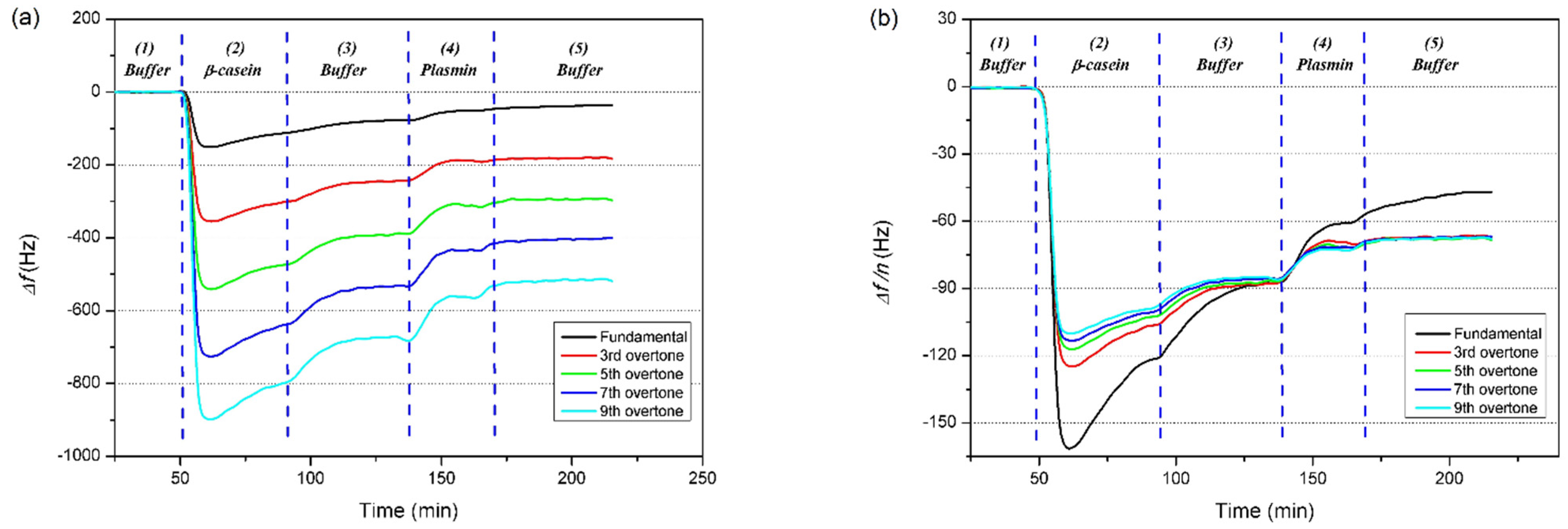
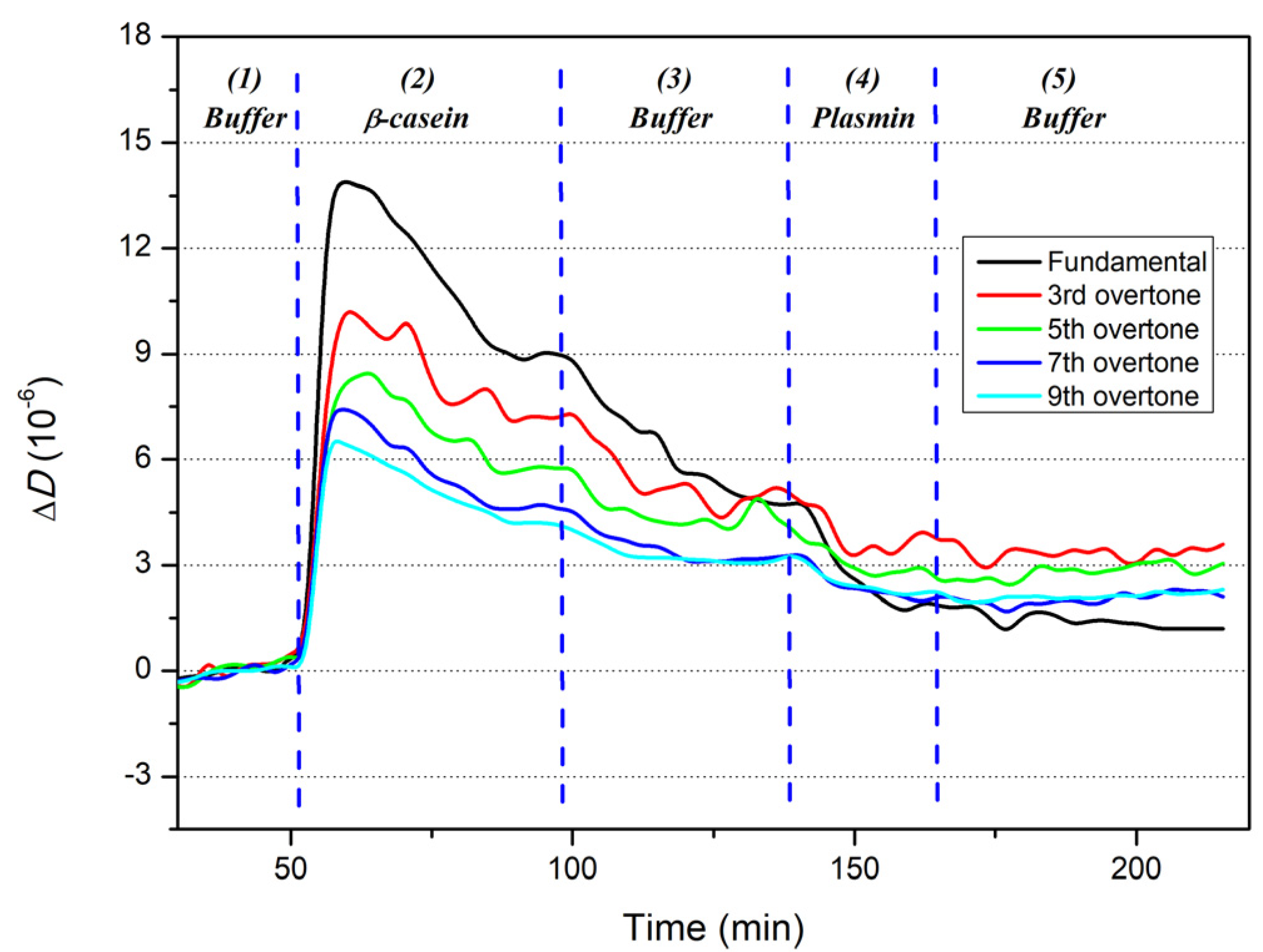
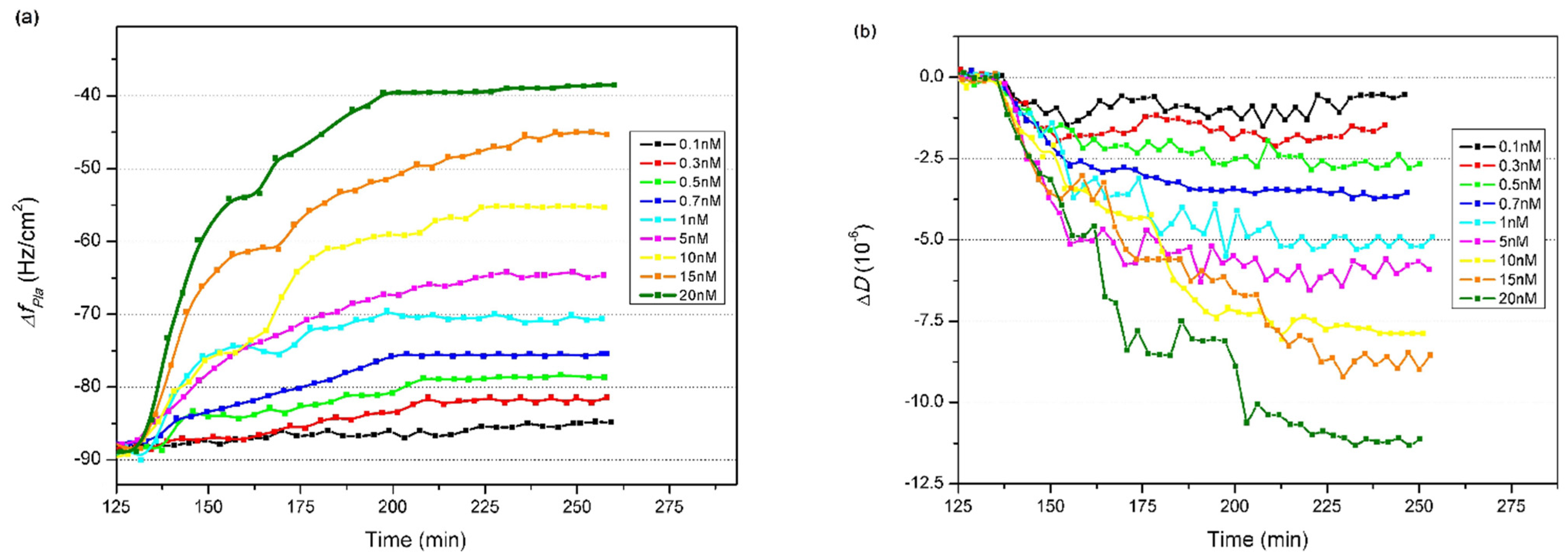
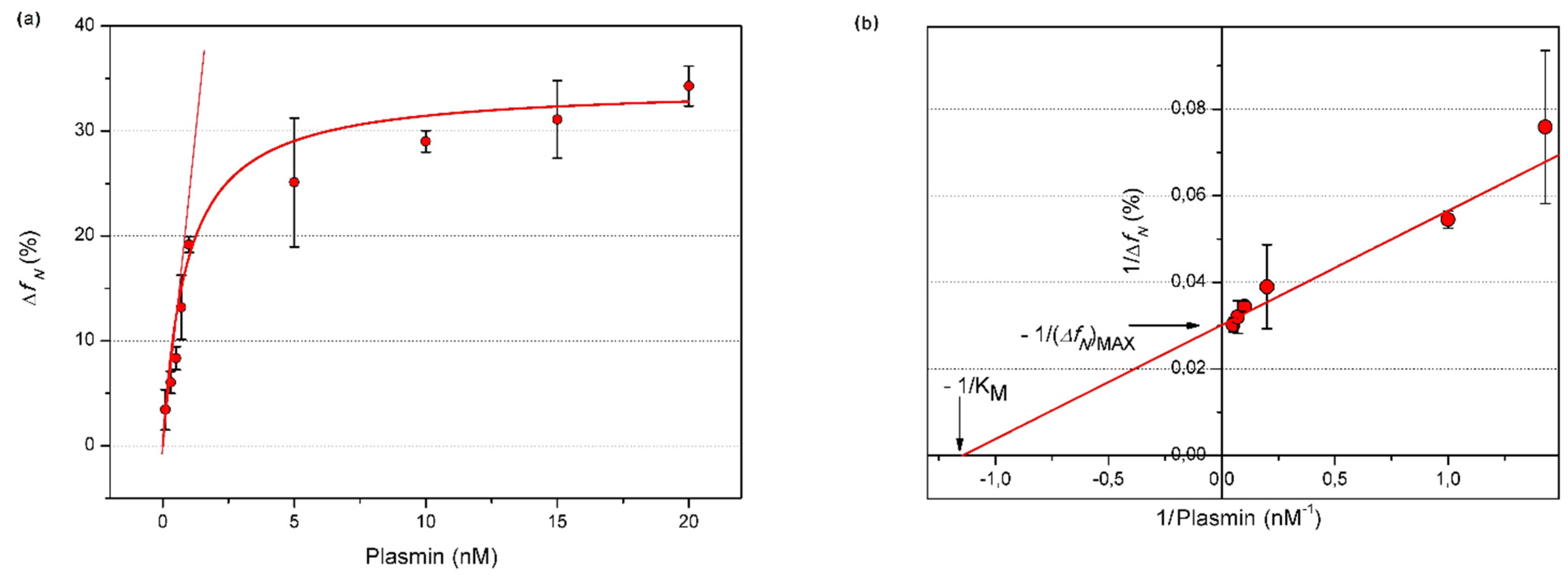
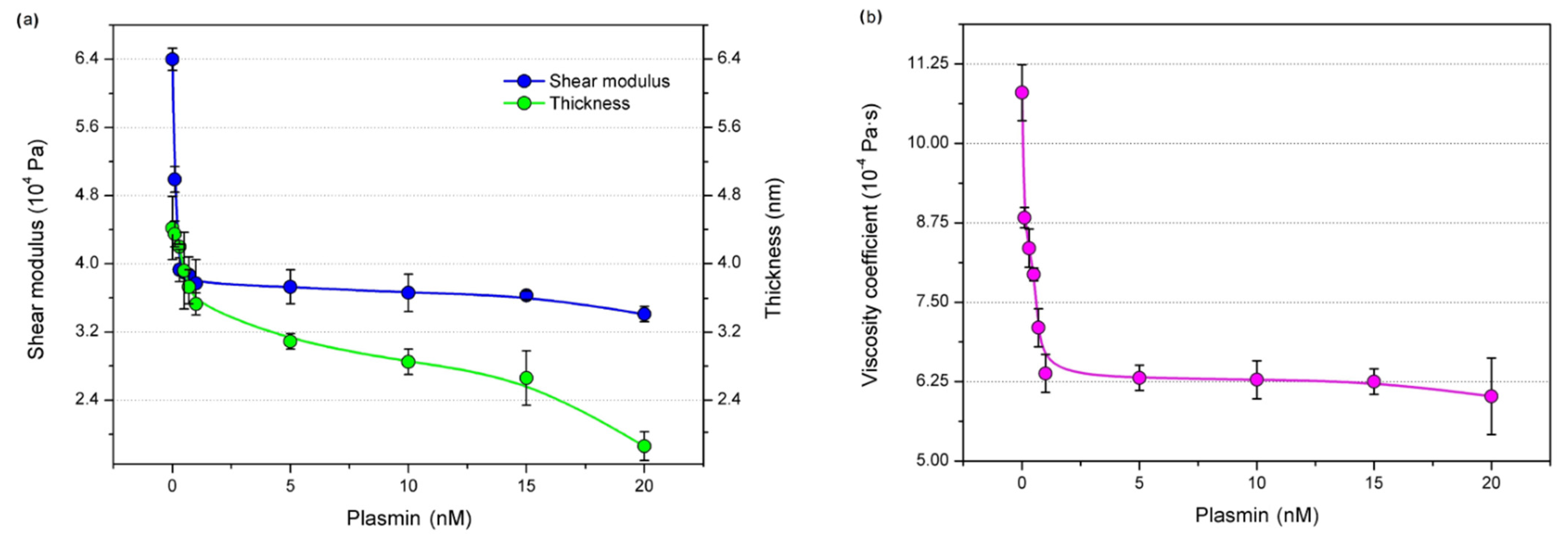
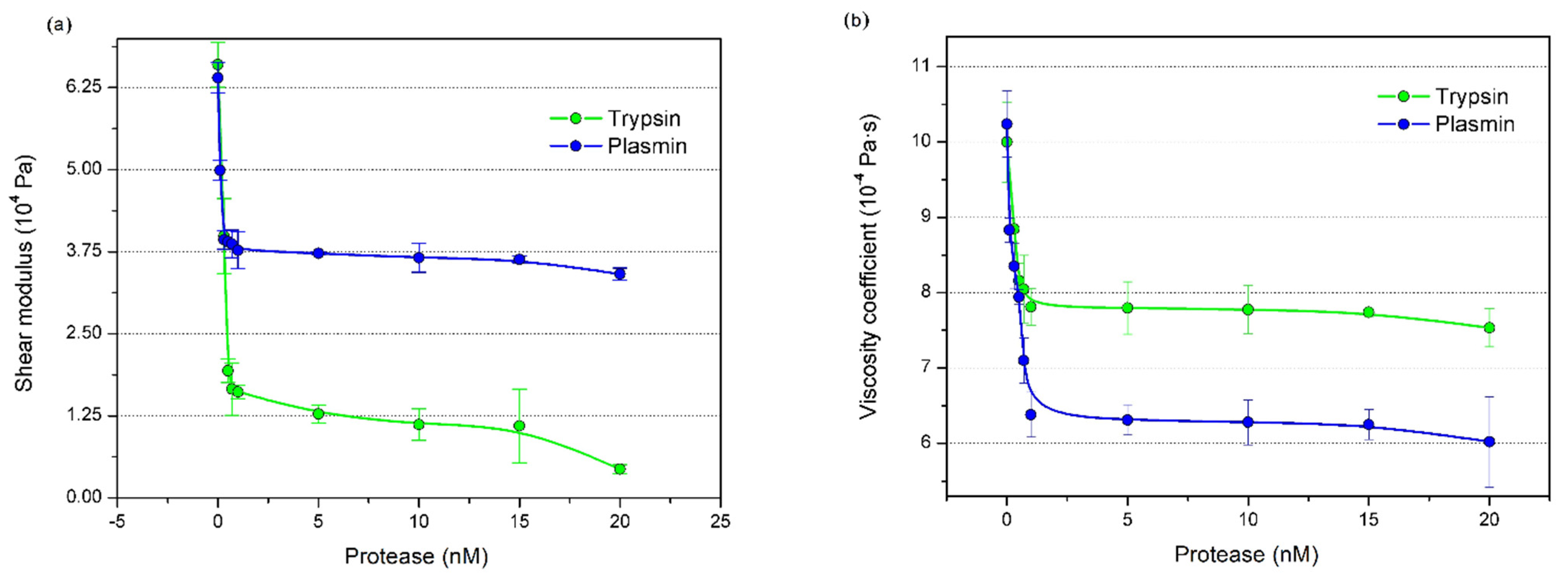
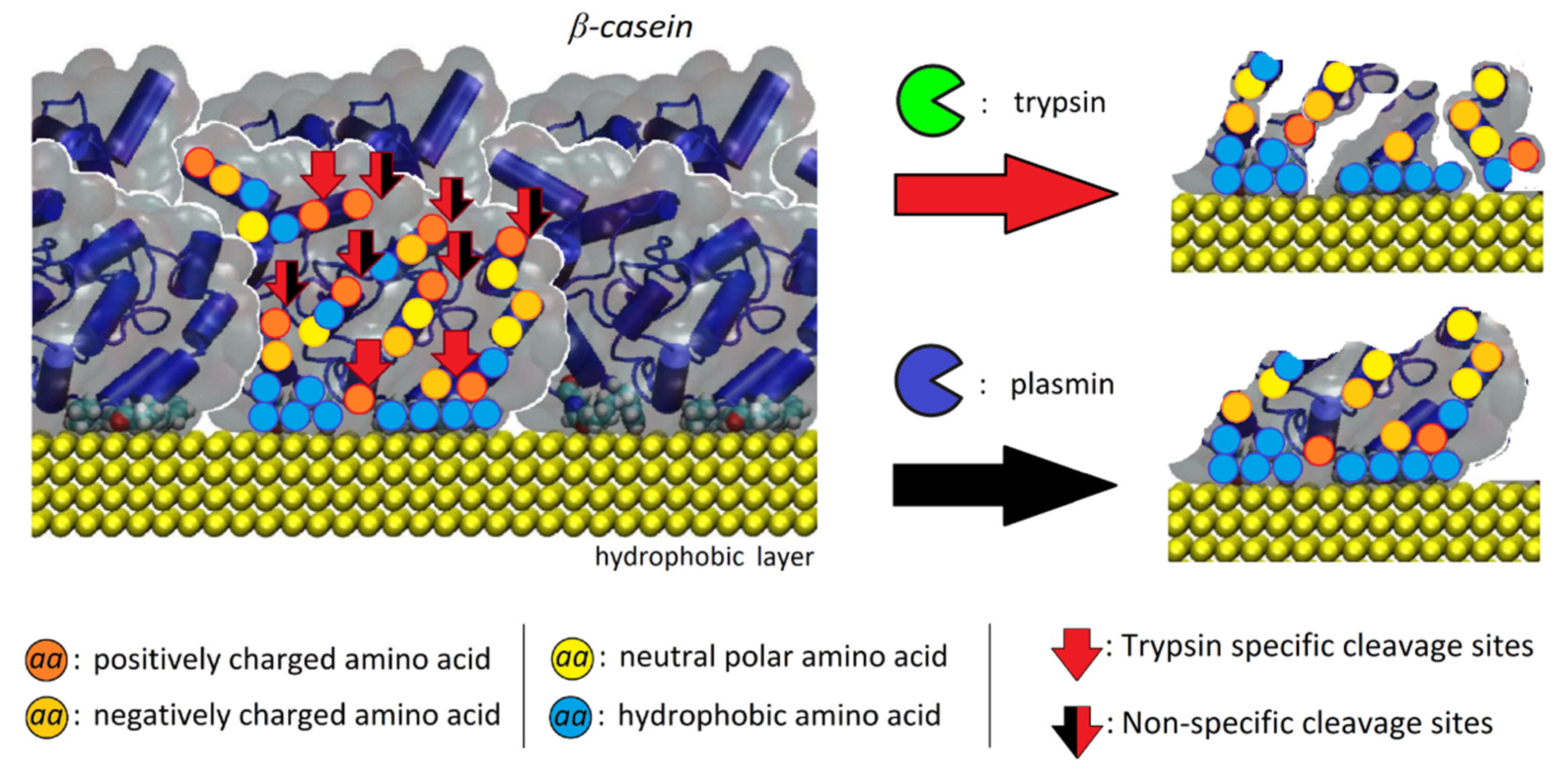
| Parameter/ Harmonics No. | Fundamental | 3rd | 5th | 7th | 9th |
|---|---|---|---|---|---|
| Δfb2/n, Hz | −120.0 ± 21.9 | −113.8 ± 3.8 | −111.9 ± 3.0 | −104.0 ± 3.1 | −103.4 ± 7.0 |
| Δfb3/n, Hz | −90.9 ± 10.9 | −89.3 ± 3.7 | −86.6 ± 4.7 | −83.8 ± 4.5 | −81.8 ± 5.2 |
| Δfb5/n, Hz | −37.5 ± 16.7 | −61.5 ± 2.4 | −59.1 ± 2.5 | −58.6 ± 3.7 | −58.2 ± 3.9 |
| ΔDb2, 10−6 | 8.7 ± 1.9 | 4.5 ± 1.0 | 3.6 ± 0.9 | 3.4 ± 0.7 | 3.0 ± 0.7 |
| ΔDb3, 10−6 | 6.8 ± 2.2 | 3.8 ± 0.8 | 3.1 ± 0.6 | 2.6 ± 0.7 | 2.2 ± 0.7 |
| ΔDb5, 10−6 | 4.9 ± 2.8 | 3.0 ±0.8 | 2.4 ± 0.6 | 2.0 ± 0.6 | 1.6 ± 0.6 |
| Parameter/ Harmonics No. | Fundamental | 3rd | 5th | 7th | 9th |
|---|---|---|---|---|---|
| ΔDb2/Δfb2, Hz−1 | 7.2 × 10−8 | 4.0 × 10−8 | 3.2 × 10−8 | 3.3 × 10−8 | 2.9 × 10−8 |
| ΔDb3/Δfb3, Hz−1 | 7.5 × 10−8 | 4.2 × 10−8 | 3.6 × 10−8 | 3.2 × 10−8 | 2.7 × 10−8 |
| ΔDb5/Δfb5, Hz−1 | 1.3 × 10−7 | 4.9 × 10−8 | 4.1 × 10−8 | 3.3 × 10−8 | 2.8 × 10−8 |
| Substrate | Method of Detection | Plasmin Source | Assay Medium | Linear Range, nM | LOD, nM | Detection Time, min | KM, nM | Ref. |
|---|---|---|---|---|---|---|---|---|
| RLuc2-Peptide-GFP | BRET | Human | TB | 0.09–3.29 | 0.03 | 10 | ND | [13] |
| RLuc2-Peptide-GFP | BRET | Bovine | TB | 0.48–8.41 | 0.26 | 10 | ND | [13] |
| RLuc2-Peptide-GFP | BRET | Human | 50% milk/TB | 0.78–44.16 | 0.25 | 10 | ND | [13] |
| RLuc2-Peptide-GFP | BRET | Bovine | 50% milk/TB | 1.19–29.92 | 0.86 | 10 | ND | [13] |
| Chromogenic substrate * | Colorimetry | Human | 50% milk/TB | ND | 1.8 | 40 | ND | [13] |
| Cromogenic substrate * | Colorimetry | Bovine | 50% milk/TB | ND | 0.5 | 40 | ND | [13] |
| Short peptide | DPV | Human | 0.2 M HClO4 | 1–12 | 0.6 | 60 | ND | [14] |
| Short peptide | CV | Bovine | PB | 1–2.5 | 0.56 | 60 | 2.5 | [15] |
| Short peptide | CV | Bovine | Milk (2.8% fat) | 1–2.5 | 0.6 | 60 | 0.8 | [15] |
| Spectrozyme PL | Colorimetry | Bovine | PB | 5–30 | 3.68 | 40 | ND | [15] |
| β-casein adlayer | EMPAS | Bovine | PB | 0.032–10 | 0.032 | 30 | 3.29 | [17] |
| Short peptide | QCM | Bovine | PB | 1–20 | 0.65 | 30 | ND | [18] |
| β-casein | QCM | Bovine | PB | 0.1–5 | 0.17 | 50 | ND | [19] |
| β-casein | QCM | Bovine | PB | 1–10 | 0.5 | >100 | ND | [20] |
| κ-casein | QCM | Bovine | PB | 1–10 | 0.2 | >100 | ND | [20] |
| Fibrinogen-AuNPs | Colorimetry | Human | Human serum | 0–50 | 0.4 | 60 | ND | [43] |
| Fibrinogen-Au NPs on MCEM | LDI-MS | Human | PB | 0–10 | 0.1 | 60 | ND | [44] |
| Short peptide | Magnetic | Bovine | PB | 0.001–11 | 0.12 | 2 | ND | [45] |
| RLuc8.6-Peptide-TurboFP635 | Optical, BRET | Human | Human plasma 7.5% | 22.5–215.4 | 11.9 | 10 | ND | [46] |
| β-casein | Mechanical | Bovine | Water | 0.33–13.3 | 0.7 | >60 | ND | [47] |
| β-casein | Ultrasound spectroscopy | Bovine | PB | 0.2–5 | 0.2 | 15–30 | 1.06 | [48] |
| β-casein | QCM | Bovine | PB | 0.1–1.0 | 0.13 | 15–30 | 0.9 | This work |
Publisher’s Note: MDPI stays neutral with regard to jurisdictional claims in published maps and institutional affiliations. |
© 2022 by the authors. Licensee MDPI, Basel, Switzerland. This article is an open access article distributed under the terms and conditions of the Creative Commons Attribution (CC BY) license (https://creativecommons.org/licenses/by/4.0/).
Share and Cite
Spagnolo, S.; Muckley, E.S.; Ivanov, I.N.; Hianik, T. Application of Multiharmonic QCM-D for Detection of Plasmin at Hydrophobic Surfaces Modified by β-Casein. Chemosensors 2022, 10, 143. https://doi.org/10.3390/chemosensors10040143
Spagnolo S, Muckley ES, Ivanov IN, Hianik T. Application of Multiharmonic QCM-D for Detection of Plasmin at Hydrophobic Surfaces Modified by β-Casein. Chemosensors. 2022; 10(4):143. https://doi.org/10.3390/chemosensors10040143
Chicago/Turabian StyleSpagnolo, Sandro, Eric S. Muckley, Ilia N. Ivanov, and Tibor Hianik. 2022. "Application of Multiharmonic QCM-D for Detection of Plasmin at Hydrophobic Surfaces Modified by β-Casein" Chemosensors 10, no. 4: 143. https://doi.org/10.3390/chemosensors10040143








